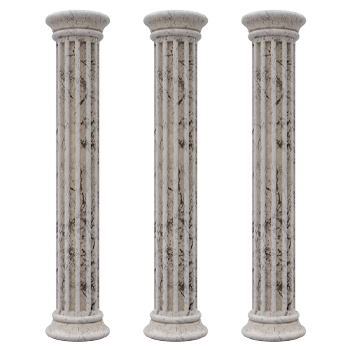

YouTube Shorts was first launched in September 2020, in response to the popularisation of short-form content platforms such as TikTok. The aim of YouTube Shorts was to create catchy videos that would be under fifteen seconds long. With creators able to film with their phones, this would up engagement and decrease cost. Several platforms have created short-form video features in response to the popularity of TikTok, including Instagram, Facebook, and LinkedIn. Three years on, YouTube Shorts is more popular than ever; now, no content strategy is complete without a host of short-form content to prime the way.
Pillared content is a tried-and-tested approach to creating a well-rounded content strategy. With the popularity of short-form content potentially at its peak, it’s essential to know how to incorporate smaller videos into a larger strategy.
‘Pillared content’ typically refers to a content strategy that involves creating a series of comprehensive and in-depth articles or blog posts on a particular topic, which are then interlinked with each other. The term ‘pillar’ refers to the main or foundational article that covers a broad topic. The subsequent articles, often referred to as ‘cluster content’ – because they ‘cluster’ around that topic – dive deeper into specific subtopics related to that pillar.
The interlinking between the pillar and cluster content helps to create a cohesive content ecosystem, which in turn provides a comprehensive resource for readers interested in the topic. This strategy is often used in search engine optimisation (SEO), as it demonstrates authority and trustworthiness, as well as expertise on a particular topic. This can help improve a website’s ranking on search engine results pages (SERPs).
Like any good ecosystem, the larger entities (long-form content) provide the right environment for smaller organisms (short-form content) to thrive.
Much like the breadcrumbs meant to guide Hansel and Gretel from the forest, YouTube Shorts are the breadcrumbs that guide interested parties to your pillared content. While it can be easy to think of these shorter videos as less important than the longer ones, it’s more accurate to understand them as having different purposes.
The core pillars, whether they’re long-form videos or cornerstone pages on your website, are there to build your authority. These pillars let your viewers know that you are well-established and experienced in your field, and that you can offer high-value, trustworthy information. Simultaneously, they build your online authority, hosting relevant keywords in a context-rich environment that lets Google knows where to send interested searches – to your website.
Short-form content clusters feed that authority, hyperlinking to relevant pages and videos to keep the connections between your different pillars alive – but this happens only when they are well-constructed. Luckily, knowing your business well enough to create appropriate pillars means that you already have everything you need to break down those pillars into more granular short-form clusters.
While short-form content such as YouTube Shorts feeds larger pillars, the reverse is also true. Well-constructed pillars inform which content should appear in your smaller videos or posts, creating a cohesive, enriched content ecosystem that builds reputable authority every step of the way. Below, we run through the broad strokes of creating a content strategy founded in clear messaging, one that feeds all aspects of your content system.

The core idea with this strategy is to create high-quality long-form content that you can break down and repurpose into shorts. To make sure that your brand comes through at every step of the way, it’s important to know your brand’s messaging and allow it to shine through. Understanding your message leads to consistency across all of your publishing channels, becoming the bedrock on which your authority is established.
Craft your message by asking yourself the following questions:
Think about Nike’s iconic ‘Just Do It’ slogan. It’s simple, no nonsense, yet uplifting and pragmatic. These are the tenets by which Nike seems to define and measure each piece of content it creates, and its ongoing success can be largely attributed to how well it understands the interests of its audience.
Your pillars define where you want to place your energy, generating content that consistently draws in customers or viewers. Using your core message, dig deeper into what your brand has to offer your audience, and find the three or four key arenas in which you operate. These are your content pillars.
Once again, we return to Nike as an example. Nike claims to have five fundamental pillars: equality, communities, manufacturing, environment, and product. In terms of content pillars, we examined some of their frequently posted content and discovered these core aspects:
Another aspect that Nike really focuses on is providing inspirational and motivational stories that go alongside their sales content.
Consider your cornerstone content as the destination. This is the place that you wish to guide your users to – the pot of gold at the end of the rainbow. Cornerstone pillar content should be high value, easily accessible and shareable, and well tied into your messaging.
For example, Nike’s ‘Just Do It’ message encourages and inspires its customers to take their fitness journey into their own hands. To that end, it has a hub of training plans that enable runners to build their fitness with no paywall needed. Not only does this build Nike’s authority as a training and fitness apparel provider, but it also builds long-term relationships with customers.
Finally, these larger cornerstone pieces are the perfect source for smaller, hyperlinked pieces that feed back to the central pillars. Long-form video is easy to mine for small snippets of short-form video, and Nike’s YouTube page is an excellent example of this.
Every long-form video falls into one of these pillars, offering high-value information or entertainment to those that land on the video. The smaller Shorts are geared towards brand awareness, routing interested parties to relevant long-form videos, which turns them towards the appropriate page on the Nike website.
These pieces are easily shareable, punchy, and packed with interesting information – without telling the whole story. They should act as teasers for further content and should interest users enough to explore further into what you offer.